#crash course anatomy and physiology
Text
Crash Course Anatomy & Physiology Notes
Part 1, Introduction to Anatomy & Physiology
"Every movement you make, and every new day that you live to see, is the result of a collection of systems working together to function properly."
anatomy act provided corpses from those that were executed
complementary of structure - basic idea that what a structure can do depends on its form
chemical > cellular > tissues > organs > organ systems > the body
the body is the highest level of organization, while chemical is the lowest level
homeostasis - the ability to maintain stable, internal conditions no matter what changes are occurring outside the body
everyone's ultimate cause of death is the extreme and irreversible loss of homeostasis
loss of homeostasis is the cause of most injuries
anatomical position - body is erect and facing forward, with arms at the sides and palms forward
standing upright
head and eyes directed straight ahead
upper limbs at the sides
upper limbs slightly away from the trunk
palms facing forward
thumbs pointing away from body
lower limbs parallel
feet flat on the ground and facing forward
the body's anatomy is split into different planes
sagittal (median) plane comes down vertically and divides a body or organ in left and right parts, plane parallel is called the parasagittal
coronal (frontal) plane splits everything vertically into front and back
transverse (horizontal) plane divides the body top and bottom
axial parts - everything in line with the center of the body, the head, neck, and trunk
appendicular parts - arms, legs, and appendages
anterior (ventral) - everything at the front of your body
posterior (dorsal) - everything at the back of your body
superior (cranial) - features towards the top of the body, like the head
inferior (caudal) - features towards the bottom of the body
structures toward the midline of your body are medial, and structures further away from the midline are lateral
proximal - areas closer towards the center of the trunk
distal - areas further from the trunk
#crash course#hank green#crash course anatomy and physiology#anatomy and physiology#a&p#notes#science#science notes#homework help#a&p notes#homework#anatomy#anatomy notes#katwthlove#crash course notes#introduction#intro notes#school#student notes#student help#john green#interesting stuff
43 notes
·
View notes
Text
It is honest to god just me and Hank Green out here during these troubling times
#what would I do without crash course. what would I do#My Anatomy and Physiology lecture slides fucking SUCK but Hank Green doesn't#Crash Course videos are structured so beautifully#can we talk about that#Those videos are able to connect the information you're learning about to something tangible so it's easier to understand#They define terms right as they appear so you can follow along for the rest of the video#Where would I be. Who would teach me if not for Hank Green#I hate you college#On the bright side this is the only class giving me any trouble so far so that is appreciated!#Oh online hybrid class where all of my in person classes are labs...why can't you just have video lectures#It's okay Hank has me he can teach me about epithelial tissues#imp tag
10 notes
·
View notes
Text

Rapid Regenerations
🧬 Cellular Overload
Regenerating is basically hitting the reset button on your whole body, and doing that back-to-back is just asking for a complete system crash. It's really tough on the cells and could lead to some very odd regenerations, where the cellular structure could become compromised, leading to forms that are incomplete or full of anomalies - limbs might not know where to go, or vital organs might not function as intended, potentially leaving the Time Lord in a perpetual state of physical instability.

🧠 Mind/Identity Trauma
Each regeneration reshuffles a Time Lord's mental deck, like getting a new brain every time you change your clothes. The continuous mental reset might lead to a loss of memories, skills, or the ability to form coherent thoughts. Over time, this could wipe out a Time Lord's sense of self, leading to a kind of identity dysphoria, where the individual might struggle to reconcile their current self with past incarnations, leading to a fragmented sense of self and potentially even self-destructive behaviour.
🌌 Temporal Issues
Messing with regenerations is a potentially temporal problem, like throwing pebbles in the time stream. In extreme cases, it could result in temporal anomalies localised around the Time Lord eg. time loops, accelerated ageing in nearby beings, or random displacements in time.
🤕 Physical Strain
And of course, regeneration hurts, particularly for Oldbloods. It's a very dastardly but also very valid form of torture. The sheer agony of undergoing repeated regenerations could lead to a state where the Time Lord might seek to actively embrace mortality to escape the cycle of pain.
🏫 So ...
So, while they'll probably survive rapid regenerations, it's a bit like pressing the reset button too many times; eventually, things might start to glitch.
Hope that helped! 😃
→🫀Gallifreyan Anatomy and Physiology Guide (WIP)
→⚕️Gallifreyan Emergency Medicine/Monitoring Guides
→📝Source list (WIP)
-------------------------------------------------------
》📫Got a question / submission?
》😆Jokes |🫀Biology |🗨️Language |🕰️Throwbacks |🤓Facts
》📚Complete list of Q+A
》📜Masterpost
If you like what GIL does, please consider buying a coffee or tipping below to help make future projects, including complete biology and language guides.
#doctor who#gil#gallifrey institute for learning#dr who#dw eu#gallifrey#gil biology#gallifreyans#ask answered#gallifreyan biology#whoniverse#time lord biology
30 notes
·
View notes
Text
a (non-official) crash course to ghoul physiology.
VOLUME 1: FIRE GHOULS
ANATOMY:
fire ghouls may have white or black sclera, but they all have vertical pupils and irises that glow a shifting, crackling yellow-orange, like the embers beneath a campfire. their irises are a reflection of their temperature; when extremely enraged, they may glow blue or white. in cases where a fire ghoul is deeply depressed or in pain, they may be completely black, like unburnt coals.
fire ghouls have no fur—they have grey skin that closely resembles that of a human, and is pleasantly warm to the touch. although any type of ghoul can have hyperpigmentation or vitiligo-like patches of skin, this most commonly manifests in fire ghouls in their hands, making them darker than the rest of their body. their horns are whitish, warm to the touch, and smaller and thinner than other ghouls’.
fire ghouls have longer and sharper fangs than other ghoul types. their tails are long and thin, and end in a spade shape.
MENTALITY:
anything goes in hell, but up above on earth, fire ghouls are more prone to developing certain personality disorders, due to their naturally explosive emotions. many fire ghouls seem to have an innate want to be self-sufficient, although all fire ghouls, and all ghouls in general, do better within an established pack.
POWERS:
fire ghouls, like most other ghoul types, are able to raise and lower their body temperature at will. to a fire ghoul, this can mean anywhere from the temperature of a weak campfire to the ability to melt metals, if they so choose. fire ghouls have the power to withstand most cold temperatures (to a point). most famously, they are able to conjure flame, although having true control of this power takes practice.
as with any ghoul type, the suppression of said powers can result in disastrous physical and mental consequences for the affected ghoul.
if y'all liked this little ghoul headcanon info-dump, i will continue to post for the rest of the elements! any feedback or ideas are appreciated!
#the band ghost#ghost band#ghost bc#ghost#nameless ghouls#nameless ghoul#ghost ghouls#fire ghoul#dewdrop ghoul#sodo ghoul#ifrit ghoul#alpha ghoul
54 notes
·
View notes
Text
Dear Sephiroth: (a letter to a fictional character, because why not) #95
I went with J, Br, and her son F to a place with animatronic dinosaurs today!!!!!!!!!!
The last time I had seen anything like this was a REALLY LONG TIME AGO (I was somewhere between 6 and 10), with my grandparents, Nanna and Poppy. And I gotta say, it was FASCINATING to be able to experience it again - this time with AUTONOMY! Holy crap!!
Also, it was amazing to be able to go to this exhibit while having an appreciation for the massive amount of work that goes into putting stuff like this together. Inside the silicone flesh of these mechanical beasts, there are robotic parts that make it move, and little speakers that make them roar!!! And then of course there's all the little details, like the arrangement of the fake tropical plants (someone needs to MAKE those! and then PLACE them!), the markings on the silicone, the order in which they are arranged, and…
And I know some bitter-ass folks will be all like, "man this shit is corny as fuck!" or "this is for BABIES!", but… well. I'm not a bitter-ass folk anymore, so here's how it actually is: a large number of people went to these incredible lengths just for the sake of making anyone who witnesses the exhibit smile, and if that's not beautiful, then I don't know what is. An incredible amount of expertise - in electricity, engineering, robotics, anatomy and physiology, paleontology, art, and more - went into making this amazing spectacle of the human imagination possible. And I think that this is a FAR better use of expertise as compared to, say, weapons manufacture. Just sayin'.
…Oh right!!! You ah… you might not know what dinosaurs are. I'm… not sure that you have them in your world. Whoops. Uh…
So basically, dinosaurs are these HUGE GIANT BIRDS and HUGE GIANT LIZARDS that used to live on my planet a LOOOONG time ago, back when the climate and atmosphere were WAAAY different than they are now (for example, the insects back in those days were HUGE because there was more oxygen to go around; nowadays, there isn't enough to support metabolic needs of bugs that size). We only know they exist because the humans of this place, much like the humans of your place, seem to enjoy digging shit up just for the heck of it. And they found bones and whole skeletons and more, preserved under layers of rock. We've done our best to try to reconstruct what these creatures might have looked like and how they might have lived, but… well… lemme put it this way: no one would know from looking at the skeleton of an orca that they're basically just these huge black-and-white ovals swimming around in the sea. Their skulls are weirdly-shaped compared to their outer appearance.
Actually. This little article sums up pretty well why we can only guess at what these animals used to look like:
It was only fairly recently discovered that most of our bipedal dinosaurs had feathers. So recently, in fact, that lots of sources of information about dinosaurs STILL haven't been updated to include the fact that they had them! But again, we can only guess what colors they were and how they were arranged.
Anyway. So, fortunately or unfortunately (I'm leaning towards unfortunately), we don't have dinosaurs anymore because they were all obliterated by a GIANT FUCKING SPACE ROCK that crashed into our planet and basically ruined everything for them. The critters on my planet that exist now are what descended from the few things that survived the resulting changes to our climate and atmosphere, because as it turns out, if THAT MUCH DUST ends up getting thrown into the sky, things get really weird, really fast.
I took pictures of the exhibit! I wanted to show you how the people of my world like to imagine what these creatures might have looked like! Here:


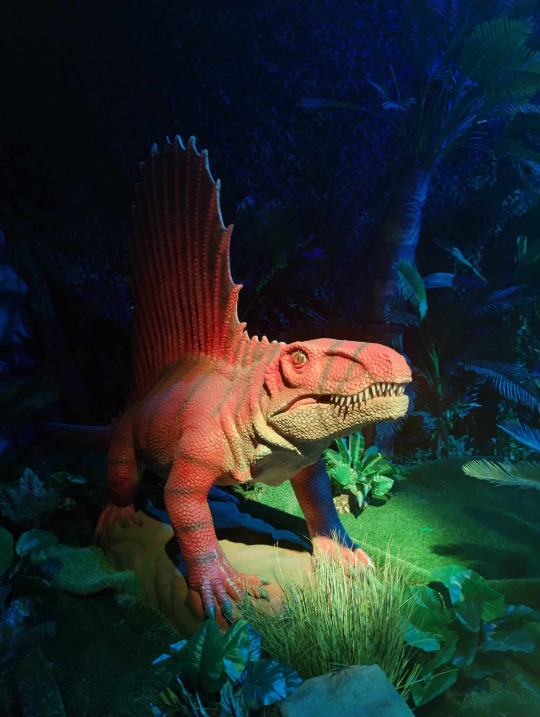



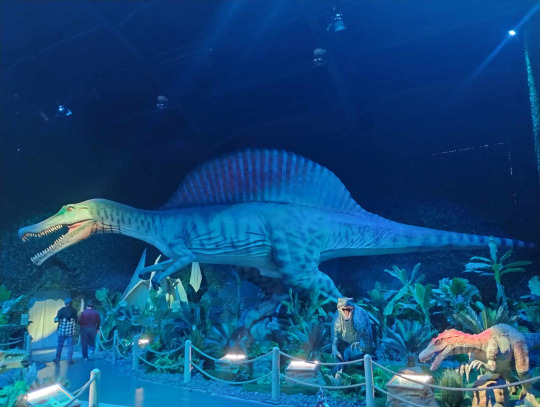
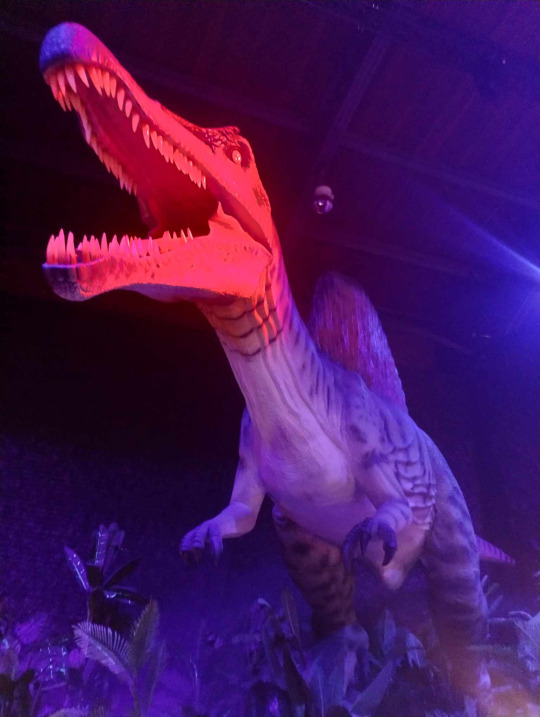
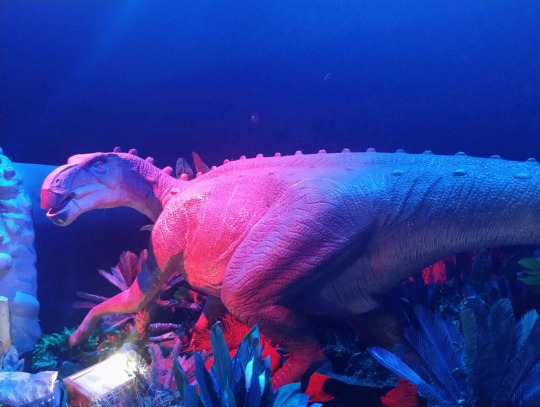
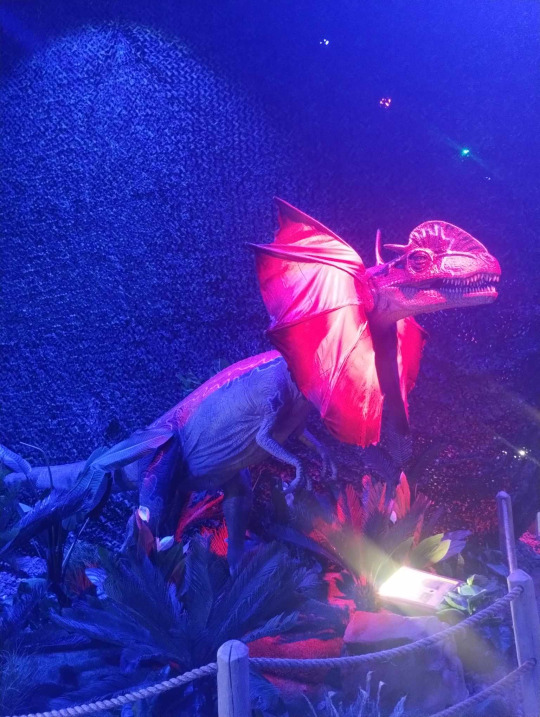
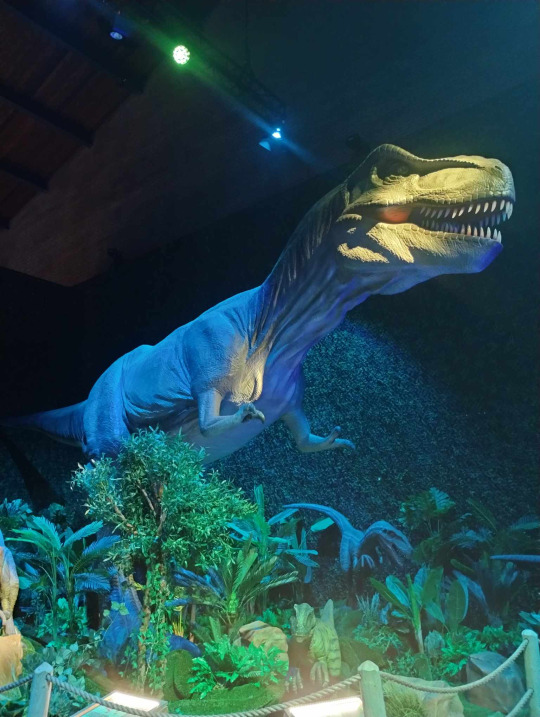


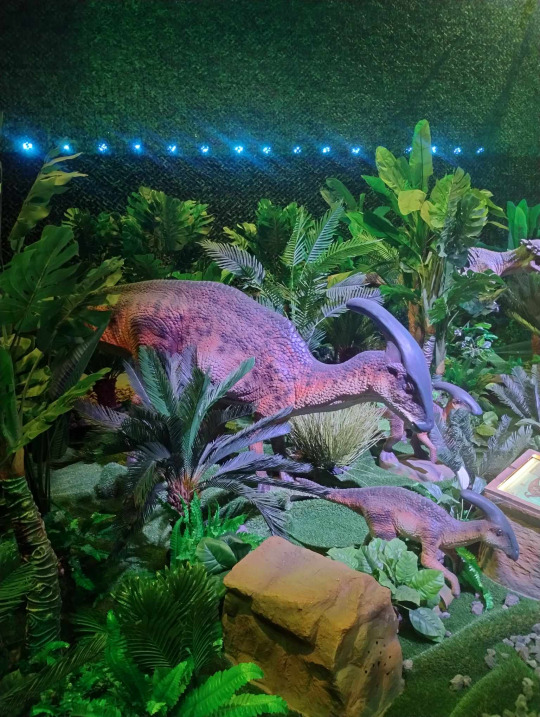


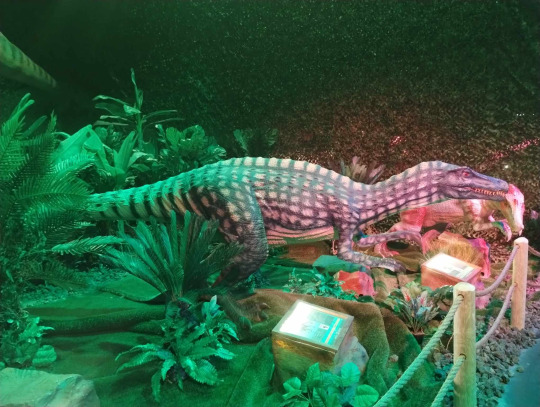
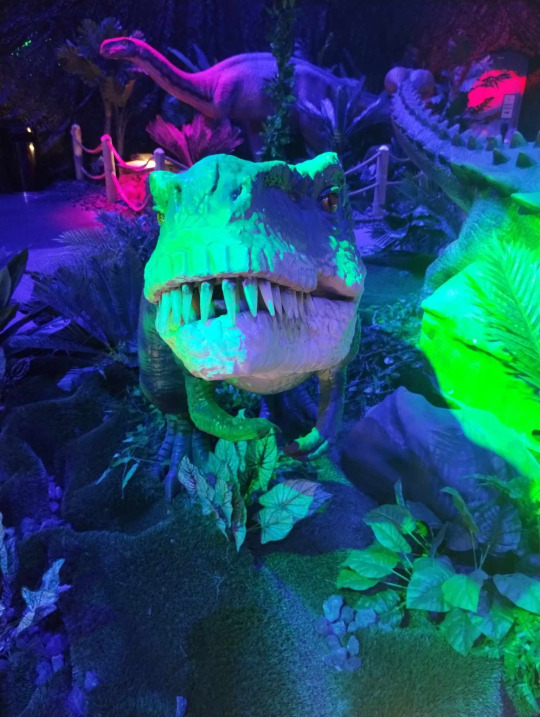


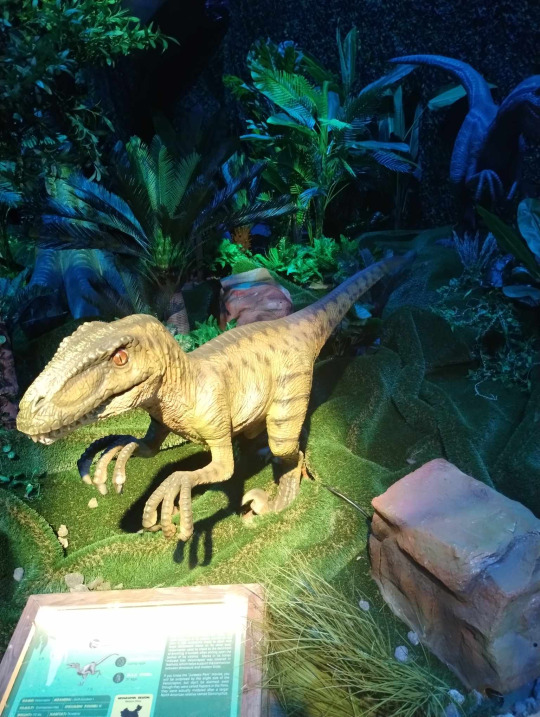

And this one... I dunno. They tried really hard to make this one very scary, I guess?
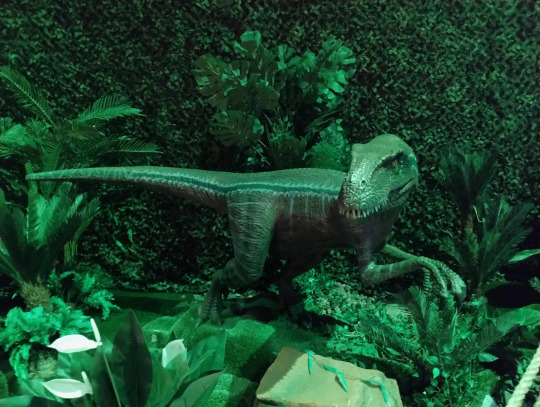
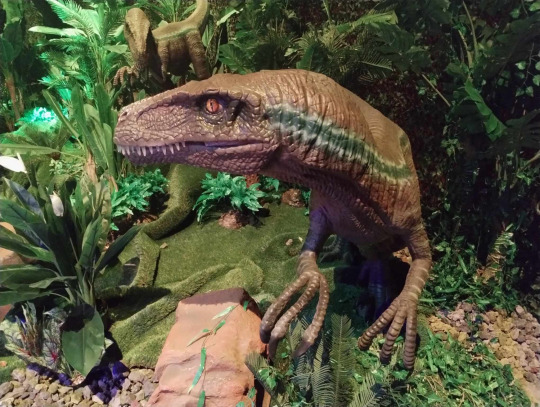
...But I dunno. This one is giving me some serious "confused toddler meme" vibes:

One of the awesome parts of being able to go to things like this as an adult, too, is that not only do I have autonomy (I can go ANYWHERE without needing someone else's permission, and NO ONE is going to tell me to "hurry the fuck up"!!!), but I also can GET THINGS from the GIFT SHOP at the end!! And NO ONE is gonna get angry at me for expressing interest in the available items!!! So I got myself this nifty-looking tea mug! Behold!
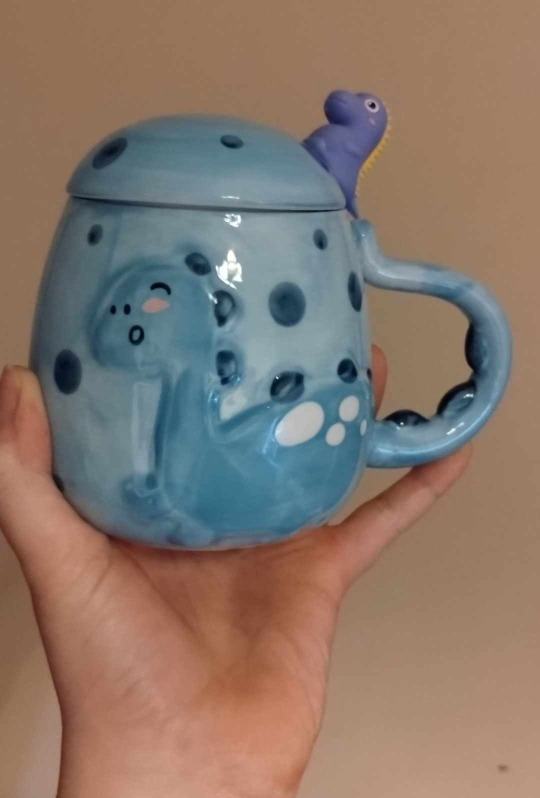
And it even comes with a TINY ADORABLE DINOSAUR SPOON!!!
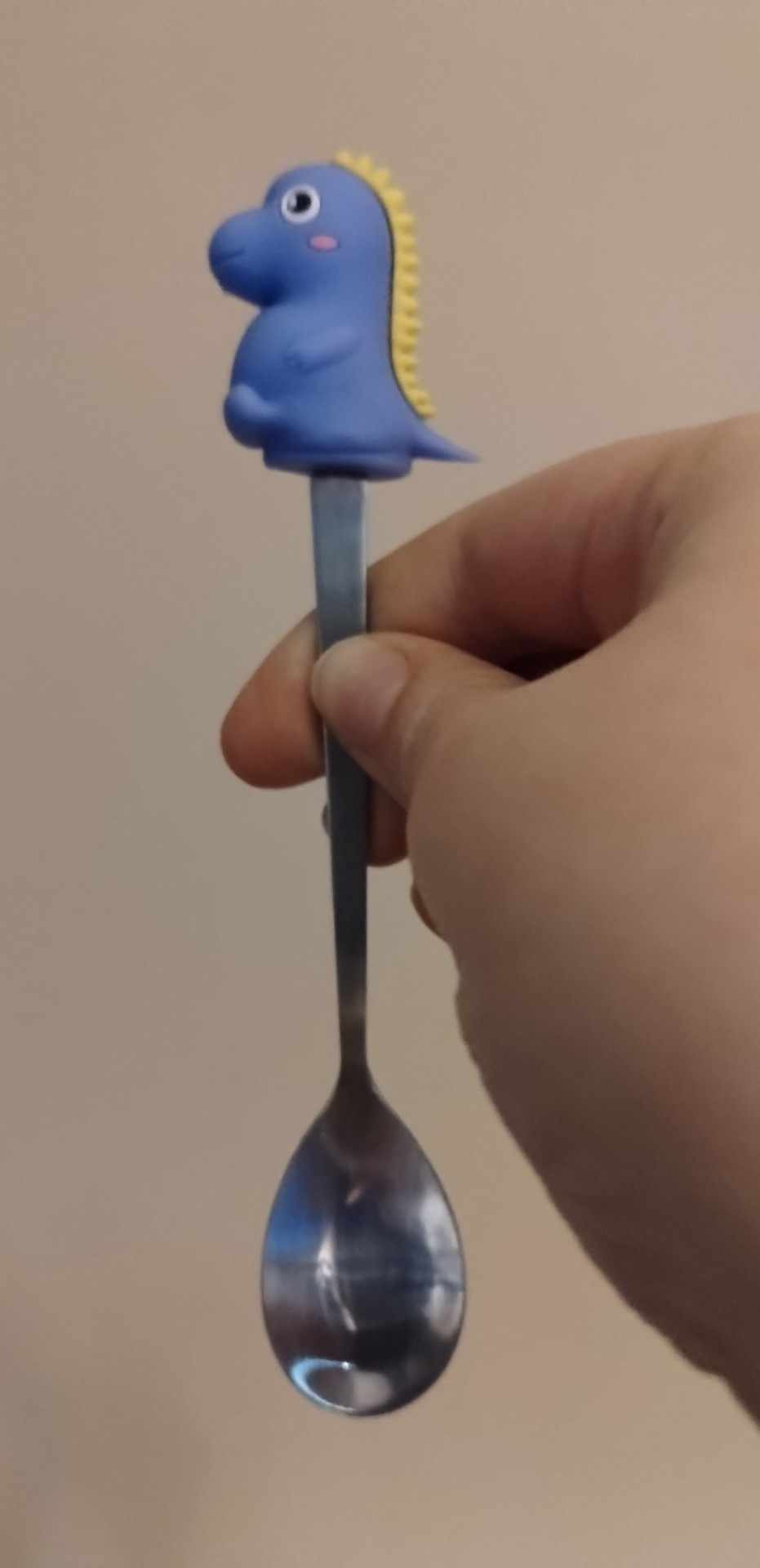
...So that's basically it for my adventures today. I really wish you were here. Just for today, I wish you could have been here.
Hey, Sephiroth? Get your shit together so that when you make it alive to the end, maybe you can go see weird animatronic dinosaurs someday, too. Okay?
I love you. I'll write again soon. Stay safe out there.
Your friend,
Lumine
#sephiroth#ThankYouFFVIIDevs#ThankYouFF7Devs#ThankYouSephiroth#final fantasy vii#final fantasy 7#ff7#ffvii#final fantasy vii crisis core#final fantasy 7 crisis core#final fantasy crisis core#ffvii crisis core#ff7 crisis core#crisis core#ff7r#final fantasy vii remake#final fantasy 7 remake#ffvii remake#ff7 remake#final fantasy vii rebirth#final fantasy 7 rebirth#ffvii rebirth#ff7 rebirth#final fantasy 7 ever crisis#ffvii ever crisis#ff7 ever crisis#ffvii first soldier#dinos alive#childhood memories#wholesome
4 notes
·
View notes
Text
Physical Trauma and Shock in Writing
Something that I think is interesting is the dichotomy of Story vs. Realism. The idea is, when you're writing with the assumption that your humanoid characters have the same basic anatomy and physiology of real-world humans, you have kind of a slider with regards to how that works out in your narrative. When writing ordinarily, much like in real life, you don't have to deal with the more technical aspects of body beyond what serves character development — most people are not terribly concerned about how long it takes to digest food, for instance, but if you make a character with gastrointestinal issues who is preoccupied with that, it might be helpful to keep a food log yourself and track how long that might take, and note what points that would be important.
Something that might happen more often in writing than in real life, however, is Physical Trauma. Maybe a character gets in a fight, and is grievously injured. Maybe they get shot. How you deal with scenes like this is going to depend on where your slider is. Maybe you have it all the way over in Story, and your character shrugs off bullets like raindrops. Maybe you have it all the way over in Realism, and your character takes one bullet graze and is constantly in excruciating pain. Maybe your slider is different for different characters (don't do this much; one of the most helpful pieces of writing advice I have been given is to be consistent — if readers smell an inconsistency, you better have a really good reason).
I recently wrote a scene that involved a character getting stabbed. Because of world-physics and reasons, I decided to put the slider fairly close to realism and, since I wanted my information to be factual and I AM NOT A MEDICAL PROFESSIONAL I had to do some research. This is what I found.
First off, let's talk physiology. Physiology differs from anatomy in that it is more concerned with a conceptual, molecular explanation for how the body works. Think "The crystal structure of this type of steel" rather than "Sword shape"; it all still relates, but in different applications. Physiologically, any body wants to remain in a neutral state (for more information about this, check out Hank Green's Crash Course Series of YouTube Videos. I highly endorse, even though I do not particularly like Hank Green) known as Homeostasis (etymologically, this word means "Same State"). Homeostasis encompasses a wide variety of factors, including, but not limited to, Hydration levels, Saturation levels in your body's various fluids, and Temperature. Your body is constantly adjusting in response to changes and stressors, in order to maintain the optimal levels of everything for peak performance.
Now, because of The Fall, the body does not always react appropriately to stressors. For instance, when you are allergic to something, your body reacts as though the allergen is a pathogen, and may do so to the extent that you die. Sometimes your body is deficient in something, and is unable to return to homeostasis (like if you're diabetic and your pancreas is broken). Sometimes you don't have enough blood, and you enter a medical condition known as —
Shock
Often when we talk about shock, we're not referring to the medical term. If someone saw something "shocking" they might be "in shock" in the sense that they need another jolt in order to get their act together. That is not the same thing.
Let's shift to Anatomy for a second. You have nerves. A lot of them. Some pretty long ones. There are a lot of divisions and subdivisions, but the two main ones we need to talk about right now are Sympathetic and Parasympathetic nervous pathways. Again, check out the videos on these two systems. Simply put, the Parasympathetic Nervous System is in charge of general maintenance and growth, while the Sympathetic Nervous System engages when your body perceives it is in danger.
The PNS, as it is referred to because I don't want to write that out every time, is in charge of "Rest and Digest" which, as that implies, means it is primarily responsible for sending resources (blood) to your visceral organs in order to facilitate the accumulation of nutrients and general upkeep and chronic repairs.
The SNS, on the other hand, is in charge of "Fight or Flight", and sends resources (blood) to Brain, Heart, and Muscles so you can deal with acute trauma.
Now, if you see something crazy, or you hear something shocking, your SNS will most likely kick in, and your heart rate will skyrocket, your pupils will dilate, you'll hear the soundtrack from Doom playing in your head, etc.
What happens with shock, however, is that your body enters this state, as it were, half-cocked.
(If you were a diesel engine enthusiast, I believe this would be referred to as runaway. Except your body doesn't typically explode when it gets too hyper.)
(Usually.)
In any case, if you get stabbed, what are you supposed to do? Leave the knife in there (or whatever) as best as you can. Blood is your body's best method of transporting oxygen, and it just so happens to also transport platelets that facilitate clotting. Removing the knife is like removing a cork, and the less blood your body has, the less able you are to function properly.
You start going into hypovolemic shock (hypo=less, vol=volume, emic=presence of blood. Hypovolemic=less volume of blood) when you lose around 15-30% of your total blood volume. Shock is typically characterized by shivering, palor, clammy skin, weakness/fatigue, and rapid heart rate.
Shock treatment is different for different ailments. If it's heat-related shock, chances are you don't want to keep someone warmer. Loosen tight clothing to increase circulation. Elevate feet to encourage upper-body circulation. Don't move someone if not necessary. Call EMS and get help as soon as possible.
(They used to say not to let people go to sleep. They don't say that anymore; it really barely matters.)
One thing they do say, which I found initially perplexing, was that you should not give someone in shock food or liquids.
Which I thought was strange. Maybe you can see why from what I've already talked about. I'll walk you through my thought process.
Shock results from lack of blood volume/dehydration. Giving someone water might be good for fluid replacement. High-sugar foods could help raise blood sugars.
Everywhere I looked said, "Well, they could choke, or aspirate the water (and get fluid in their lungs and maybe get a bacterial infection)" to which I thought, "Well, if I'm really careful, and the person in shock was really lucid, I could probably get some food down with no issues. Maybe if it's mushed up or something."
Do you know the Number One reason why you don't feed someone in shock? I'm belaboring this point because even if you don't trust your abilities, or your gut, your gut may really mess you up here.
It's an Anatomy and Physiology issue. Blood Loss and your Sympathetic Nervous System. While in shock, your body does not digest food or fluids because your PNS is not engaged. While in [hypovolemic] shock, you have less blood available for your body to use. If you eat or drink while in shock, you put more unnecessary stress on your already super-stressed body, and demand more resources that aren't there, thus taking away the limited resources your body needs to keep itself alive.
And you might choke and die from eating a candy bar.
And you might get a bacterial infection, malinger and die from drinking some soda. Fun fact: the PNS (you know, the one that is not engaged) is responsible for fighting off infections, so any infections you accrue are going to have Compounding Interest by the time your body gets around to dealing with them — great for your bank account, horrible for your lungs.
I just wanted to really hammer that home. I have a highly competitive nature (hidden under the surface a bit), and telling me there's a mechanical solution to a problem engages that competitive side massively. If it isn't something I could possibly fix, I can focus on other things, like actually helping someone in shock instead of increasing their likelihood of dying.
If nothing else, you can look at it like a priority list. First you put your certainties, then your less-certainties, then your peripherals.
You will definitely slow your entire system down if you ingest food or imbibe water.
You might choke on large chunks of food.
You might aspirate water into your lungs and get pneumonia.
You could possibly screw up diagnostics when EMTs arrive.
Anyway. That has always bothered me. I'm a curious person, and I also consider myself fairly learned and careful. I don't think I'm the only one.
Oh yeah, usually EMTs won't just give people a saline drip, either. I always thought the blood volume was the biggest thing, but no. If you're trying to bring up volume, you start a blood transfusion (whole blood if available). Saline dilutes the blood and lessens clotting factors.
Anyway.
There's some of my research for you.
Again, I am not a medical professional. Do your own additional research. Get CPR certified.
0 notes
Text
Aesthetic Medicine/Cosmetology Course for Dermatologists – What you must Know
-- September 01, 2022

The dermatology field is growing at an exponential rate because of the high demand for cosmetic services. An increasing number of people are investing in aesthetic medicine treatments to help them improve their appearance and feel great. So, if you are a medical professional who loves working with patients and exploring your mind in order to find out the cause of skin diseases, you should consider studying aesthetic medicine and cosmetology courses at KAAM Academy. It is becoming more popular among students as it is not only interesting but also has good career opportunities after doing the courses. This article will help you to understand the market growth in the aesthetic medicine and cosmetology sector, what aesthetic medicine and cosmetology courses are, who can do them, and how these courses impact on your career after completion of your education.
How dermatologists and other doctors can specialise themselves in aesthetic medicine and cosmetology courses
Medical professionals who specialise in dermatology can expand their dermato-surgical abilities by going through different training programs in Injectables and Lasers through certificate programs provided at various academies. MBBS doctors, Ayurvedic graduates, Dermatologists, or Homoeopathy experts can become aesthetic experts in the wake of finishing a crash course or a certificate course of one year. Gaining expertise in medical aesthetics or cosmetology allows one to work in national or international aesthetic clinics. They can also opt for starting their own ventures in India or abroad as the aesthetic medicine and cosmetology market is expanding rapidly every year.
Aesthetic courses focus on various skin, hair, and body services such as Platelet Rich Plasma (PRP), Laser Hair Reduction (LHR), botox and fillers. The keen aspect of KAAM courses is equal importance to the theory and hands-on training on injectables ( botox & fillers). Other modules include chemical peeling, pigmentation, skin tightening and conditioning, advanced spot reduction, hair loss/regrowth services, scar management, and other common aesthetic concerns. Along with theoretical studies, handling emergency situations, how to consult the clients with good communication skills and recommended body language are taught. Separate coursework for clinic setup framework and office management are discussed in detail.
Any MBBS graduate, plastic surgeon or physician can stay ahead of the curve pace with those innovations and changing trends of the industry by learning about botox treatment- mechanism, contraindications, technique of injecting the formulations, assessing the face and learning about post treatment care. Fillers are the new advanced technology and the course consists of selecting clients for the treatment, dermal and hydra fillers with their formulations, contraindications and the precautions one must take in order to do fillers. For Ayurveda or Homoeopathy graduates/experts, specific modules of skin physiology and anatomy, pigmentation, pharmacology and skills of consulting clients are included in our courses.
Not only doctors, nursing graduates can also establish a strong groundwork in the developing field of aesthetic medicine. They could opt for a 30 days course framework which includes theory as well as practical lectures on Laser Hair Reduction (LHR), skin tightening, botox & fillers, and many more. Chemical peeling is a module which is sought out by many professionals.
Academy for studying aesthetic medicine and cosmetology courses
Kosmoderma Academy of Aesthetic Medicine (KAAM) offers aesthetic medicine and cosmetology training in which the medically trained professionals, attendants, doctors, dermatologists and paramedical work-force get the opportunity to join online courses in aesthetic medicine and cosmetology. The aesthetic training institute by Kosmoderma Skin Hair Body Clinics was founded by Dr. Chytra V Anand, an internationally renowned celebrity dermatologist. KAAM also provides 2-3 days workshop for aesthetic and cosmetology professionals who want to learn a particular or new skill. Short and long courses offer 360º openness and active experience for students who anticipate rehearsing or working in aesthetic facilities/clinics or the cosmetic business. KAAM syllabus is upgraded through continuous research and is packed with key theoretical plus practical knowledge to succeed in related workplaces.
Market growth in aesthetic medicine and cosmetology sector
Aesthetic medicine and cosmetology stands tall with an estimated global medical aesthetic market and cosmetology size of USD 9.4 billion assessed in 2020. The Aesthetic medicine and cosmetology industry is growing with a promising CAGR of 10.9%. The projected global medical aesthetic market and cosmetology size in 2025 is USD 15.9 billion.
There are several factors that account for global market growth. With the beginning of selfie culture and an openness towards conversation about aesthetic services, it appears to be normal that new age clients have a growing interest in cosmetology & medical aesthetics at a young age. Among all age groups, the young generations show key interest. The spending capabilities have been increased among the people as compared to their incomes. Working on their actual appearance, lessening scars, and reproducing deformed regions is what medical aesthetics stands for and youth know it better today than in the past. Individuals now feel more confident and comfortable to work on their appearance by perfecting facial highlights like jaw, lips or nose or going through innovative aesthetic services. Thanks to countless aesthetic and cosmetology professionals worldwide for demystifying the stigmas around injectables and related services.
Many do cosmetology courses to boost their aesthetic medicine career. They can work with reputed aesthetic centres and medical clinics overall or can begin their pioneering ventures. As you see, with its amazing opportunities that the Aesthetic medicine and cosmetology sector offers to us as a whole, and the huge potential for career progression in this field, it is not a surprise why more and more people are interested in joining these courses. If you are also one of them, you should also check out our courses. KAAM is the best choice for students who want to study in this field. The academy always strives to give energetic students a holistic and complete learning experience with 360-degree growth opportunities, active mentoring sessions on live models and real-time clinic observership sessions.
#cosmetology course for dermatologists#certificate in hair transplant#advance certificate in medical cosmetology#advanced diploma in aesthetic medicine#aesthetic injector training#advanced cosmetology courses#medical aesthetics training#advanced diploma in cosmetology
0 notes
Text
Winter Short: Storytelling, Featuring the Actin-Myosin Love Story | TAPP 130
Host Kevin Patton revisits some classic segments from past episodes. In the first segment, he explains why he thinks storytelling is the heart of effective teaching. Then. he tells a brief version of his actin-myosin love story—a playful analogy to help students learn about muscle contraction.
00:00 | Introduction
01:07 | Storytelling: The Heart of Teaching
15:36| Sponsored by AAA, HAPI, and HAPS
17:10 | Actin-Myosin Love Story
27:58 | Staying Connected
★ If you cannot see or activate the audio player, go to: theAPprofessor.org/podcast-episode-130.html
🏅 Apply for your credential (badge/certificate) for listening to this episode: theAPprofessor.org/podcast-episode-130.html/#badge
⭐⭐⭐⭐ Please rate & review this podcast so that others can decide whether to give it a try: RateThisPodcast.com/theAPprofessor
❓ Please take the anonymous survey: theAPprofessor.org/survey
☝️ Questions & Feedback: 1-833-LION-DEN (1-833-546-6336)
✔️ Follow The A&P Professor on Twitter, Facebook, Blogger, Revue, Tumblr, or Instagram! @theAPprofessor
📰 Get the thrice-weekly TAPP Science & Education Updates theAPprofessor.org/updates
Guess what? This is another one of our winter shorts! Yep, that's right, it's a shorter-than-usual episode in which I present one or two, or maybe three or four, classic, evergreen segments from previous episodes that are remastered, reconstituted, and recycled for your listening and learning pleasure. But mainly it's to give me a break for self-care over the holiday season. We'll be back to our regular programming in late January.
Storytelling is the Heart of Teaching
14.5 minutes
Kevin explains why he thinks storytelling is the heart of effective teaching, especially in the A&P course. He outlines the "storytelling persona"; making sure there is a beginning, middle, and end to our stories, applying storytelling to both lectures and the entire course, using drama, conflict and resolution, and other techniques.
★ This segment was first heard in Storytelling is the Heart of Teaching A&;P | Episode 12 and The Storytelling Special | Episode 48
★ Educational Uses of Digital Storytelling (website with many resources)
★ Crash Course in Storytelling (book on the basics of storytelling)
★ Long Story Short: The Only Storytelling Guide You'll Ever Need (book; the title says it all)
★ Anatomy & Physiology Syllabus: It's an Art | TAPP 120 (how the syllabus tells a story)
★ Teaching Slides: Smooth and Simple Animations Dramatize the Story of A&P | TAPP 89
★ The Proper Order of Topics in A&P | Leaderboards | Student Frustration | TAPP 88
Sponsored by AAA, HAPI, and HAPS
90 seconds
A searchable transcript for this episode, as well as the captioned audiogram of this episode, are sponsored by the American Association for Anatomy (AAA) at anatomy.org.
Searchable transcript
Captioned audiogram
The Master of Science in Human Anatomy & Physiology Instruction—the MS-HAPI—is a graduate program for A&P teachers, especially for those who already have a graduate/professional degree. A combination of science courses (enough to qualify you to teach at the college level) and courses in contemporary instructional practice, this program helps you be your best in both on-campus and remote teaching. Kevin Patton is a faculty member in this program at Northeast College of Health Sciences. Check it out!
northeastcollege.edu/hapi
The Human Anatomy & Physiology Society (HAPS) is a sponsor of this podcast. You can help appreciate their support by clicking the link below and checking out the many resources and benefits found there. Watch for virtual town hall meetings and upcoming regional meetings!
Anatomy & Physiology Society
theAPprofessor.org/haps
The Actin-Myosin Love Story
11 minutes
Kevin tells the story of actin and myosin a characters in the process of sliding filaments during contraction as an analogy to a classic love story. This playful story reflects the focus of many past episodes about the use of storytelling and analogies in teaching A&P.
★ This segment was first heard in Actin & Myosin & A Love Story | Episode 15
★ Episode 12: Storytelling is the Heart of Teaching A&P (introduces the strategy of storytelling)
★ Episode 13: Playful and Serious is the Perfect Combo for A&P (introduces the value of playful analogies)
★ Survival Guide for Anatomy & Physiology (Kevin's brief manual for A&P students features a version of the actin-myosin love story)
★ Excitation-Contraction Coupling in Skeletal Muscle: A Love Story? (article from HAPS Educator with a version of this story)
★ Metaphors & Analogies: Power Tools for Teaching Any Subject (book that addresses many issues, including English-language learners)
People
Production: Aileen Park (announcer), Andrés Rodriguez (theme composer, recording artist), Rev.com team (transcription), Kevin Patton (writer, editor, producer, host)
If the hyperlinks here are not active, go to TAPPradio.org to find the episode page.
★ More details at the episode page: theAPprofessor.org/podcast-episode-130.html
★ Transcript available in the transcript box: theAPprofessor.org/podcast-episode-130.html
★ Need help accessing resources locked behind a paywall? Check out this advice from Episode 32 to get what you need! my-ap.us/paywall
Take The A&P Professor experience to the next level!
★ theAPprofessor.org/community
Earn cash by referring other A&P faculty to this podcast:
★ theAPprofessor.org/refer
Tools & Resources
★ TAPP Science & Education Updates: theAPprofessor.org/updates
★ Amazon: amzn.to/2r6Qa3J
★ Text Expander: theapprofessor.org/textexpander
★ Rev.com: try.rev.com/Cw2nZ
★ Snagit & Camtasia: techsmith.pxf.io/9MkPW
★ Krisp Free Noise-Cancelling App: theAPprofessor.org/krisp
★ JotForm (build forms for free): theAPprofessor.org/jotform
★ QuillBot (writing tools): theAPprofessor.org/quillbot
★ The A&P Professor Logo Items: https://www.teepublic.com/stores/the-a-p-professor
Sponsors
★ Transcript and captions for this episode are supported by the American Association for Anatomy | anatomy.org
★ The Human Anatomy & Physiology Society provides marketing support for this podcast | theAPprofessor.org/haps
★ Distribution of this episode is supported by the Northeast College of Health Sciences online graduate program in Human Anatomy & Physiology Instruction (HAPI) | northeast.edu/hapi
Clicking on sponsor links helps let them know you appreciate their support of this podcast!
Follow The A&P Professor on Twitter, Facebook, Blogger, Revue, Tumblr, or Instagram @theAPprofessor
The A&P Professor® and Lion Den® are registered trademarks of Lion Den Inc. (Kevin Patton)
As an Amazon Associate I earn from qualifying purchases. I may be compensated for links to sponsors and certain other links.
Check out notes and transcript for this episode!
0 notes
Video
youtube
Parasympathetic Nervous System: Crash Course Anatomy & Physiology #15
0 notes
Text
I still think about this dream a lot
When I was taking a human anatomy course in college, I had to watch a lot of "Crash Course To Human Anatomy" (at least one to three videos every week for a good grade), which was a YouTube series where Hank Green would explain the concepts of anatomy and physiology in a very fast and humorous way. One night I had this dream where I was in a room that was completely dark except for a lit up corner that had a ticking time bomb which I had to diffuse, but as soon as I began to star diffusing it, the intro music to Crash Course began to play. I then noticed a previously dark corner of the room was lit up to reveal the set to Crash Course, which consisted of a couple of odds and ends but was mostly taken up by a large desk that Hank Green sat behind to do his educational bit. Anyways, Hank then starts to talk about bones and muscles in his usual fast paced teaching style, which was stressing me out greatly because I had to diffuse a bomb. Suddenly, I had a great idea. Since Hank knows a lot about sciency things and what not, maybe he can diffuse this bomb. So I call out to him. "Hey genius! Can you shut up and walk over here to diffuse this bomb?" Hank then stops and looks me dead in the eye, which had an evil sort of glint and says "Bold of you to assume I have LEGS!" And with that, he somehow pushes the entire desk aside to reveal that he is only a torso on one of those mannequin stands that is propped up in his chair.
And then without skipping a beat, he resumed talking about bones and muscles.
#Dreams#Hank Green#I don't even know#Crash Course#Anatomy#Does this dream have a deeper meaning?#Does Hank Green have legs?#I never actually seen his legs so my dream could be legit#Forgive my bad English I am a tired college student
0 notes
Text
Crash Course Anatomy & Physiology Notes, Tissues, Part 1
every cell in the body has its own specific job related to maintaining homeostasis
cells are the most basic building blocks in the hierarchy of complex structures
tissues are the fabric of the body
when 2 or more tissues combine, they form organs
type of tissue defines its function
there are 4 primary tissues
nervous tissue provides control and communication
muscle tissue gives movement
epithelial tissue lines the body cavities and organs and cover and protect the body
connective tissue provides support
histology - the study of tissues
carmine - a red dye derived from the scales of crushed-up cochineal insects, used to highlight different cell structures
nervous tissue forms the nervous system which regulates and controls the body's functions
nervous tissue senses stimuli and sends electrical impulses through the body in response to those stimuli
nervous tissue is made up of two types of neurons and glial cells
neurons sense stimuli and send messages to your brain
neurons are made up of the cell body (soma), dendrites, and the axon
cell body (soma) is the cell's life support, it has all the necessary parts like a nucleus, mitochondria, and DNA
dendrites are bushy and look like the trees that they're named after, they collect signals from other cells to send back to the soma
axon is long and rope-like, it's the transmission cable and it carries messages to other neurons and muscles and glands
glial cells provide support, insulation, protection and tether to blood vessels
muscle tissues can contract and move
the three types of muscle tissue are skeletal, cardiac, and smooth
skeletal muscle tissue attaches to all the bones in your skeleton, it pulls on the bones or skin when they contact to make your body move
skeletal tissue is made up of multinucleate and striations
cardiac muscle tissue cells are generally uninucleate meaning one nucleus, have striations
smooth muscle tissue lines the walls of the blood vessels and hollow organs, don't have striations
#science#science notes#anatomy#crash course anatomy and physiology#anatomy and physiology#anatomy notes#crash course notes#crash course#hank green#tissues#tissues notes#as promised#sorry not really sorry#cool science
31 notes
·
View notes
Text
If you haven't heard yet, Crash Course is having live study sessions where they will take any questions you have on flipgrid and answer them live on their youtube channel.
Heres the sessions:
Anatomy & Physiology - April 11th at 6:30 PM EST
Geography - April 13th at 7 PM EST
World History - April 14th at 7 PM EST
Source
#i have an A&P exam coming up so this will be VERY helpful#crash course#studyblr#study help#anatomy and physiology#geography#world history#john green#hank green#alizé carrère
3 notes
·
View notes
Photo

trying to get a head start on anatomy and physiology by watching crash course’s series on the topic! here are my notes for tissues part 1.
filmed the main content for my youtube video
finished rereading the battle of the labyrinth
went to my voice lesson and practiced the song without music
#anatomy#physiology#notes#mine#crash course#john green#hank green#science#studyblr#studyspo#100daysofproductivity#100 days of productivity
7 notes
·
View notes
Text
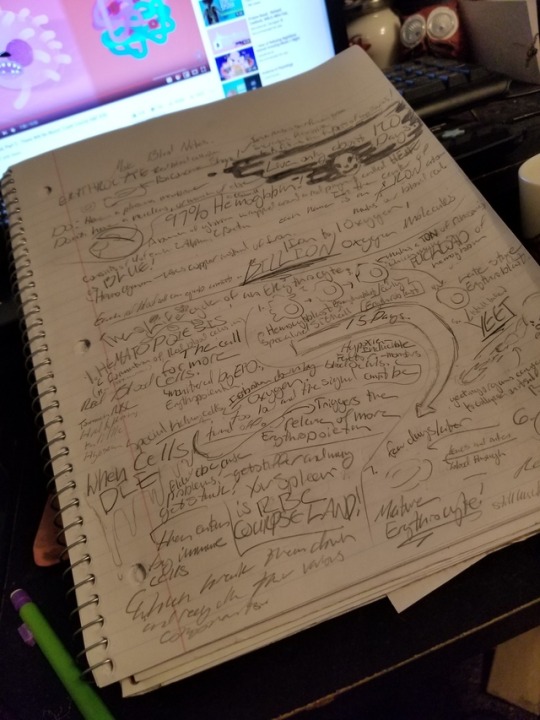
Poor planing leads to running out of space. :(
Bonus: my favorite doodle

#studyblr#studygram#notes#note taking#anatomy and physiology#blood#red blood cells#crash course#my post
9 notes
·
View notes
Text
Immune System, part 2: Crash Course A&P #46
Immune System, part 2: Crash Course A&P #46
In the penultimate episode of Crash Course Anatomy & Physiology, Hank explains your adaptive immune system. The adaptive immune system’s humoral response guards extracellular terrain against pathogens. Hank also explains B cells, antibodies, and how vaccines work.
Crash Course A&P Poster: http://store.dftba.com/products/crashcourse-a…
View On WordPress
#adaptive immune system#Anatomy#antibodies#b cells#Crash Course#crashcourse#Education#Hank Green#humoral#humoral response#immune system#John Green#pathogens#Physiology#Science#vaccines#vlogbrothers
3 notes
·
View notes
Conversation
Random anime/manga as YouTube titles (part 2):
Jujutsu Kaisen: I Just Ate this Guy's FINGER (NOT CLICKBAIT) - Finding ItaDory Vlogs
Cells at Work: Introduction to Anatomy & Physiology: Crash Course A&P #1
Mirai Nikki: Is My Girlfriend A SERIAL KILLER?! pls halp - Preventing the Apocalypse Challenge
Dragonball Z: I Create the World's Biggest SPIRIT BOMB (I Lost My Voice After This) - KakaGOD Vlogs
YuYu Hakusho: Lol my finger gun goes BRRR (spoiler alert: it shoots spirit energy lmao) - GhostCop Vlogs
To Your Eternity: We will, we will...ROCK you! (i'm dead on the inside) - Yo Fushi Vlogs
My Hero Academia: DID #1 HERO ALL MIGHT JUST ADOPT ME?!?! - Count Deku Vlogs
Death Note: JUST ACCORDING TO KEIKAKU!!! - TheLightSide Vlogs
Baccano!: Life During the Great Depression (not me, the time period) - Finding the Immortality Elixir Challenge
Haikyuu!!: So I got into a fight with my teammate... - The Other Little Giant Vlogs
Kuroko no Basket: Is This Basketball or Are We Fighting the AVENGERS?!?! - The6thGuy Vlogs
Kakegurui: HITTIN THE JACKPOT IS GONNA MAKE ME [demonetized]!!! - NotCelestiaLudenberg Vlogs
Don't Toy With Me, Ms. Nagatoro: THIS GIRL IS DRIVING ME INSANE (she kinda bad tho) - ChadPai Vlogs
Rent-a-Girlfriend: My Rental Girlfriend Meets My EX-GIRLFRIEND (OH NO 😱) - ImDownBad Vlogs
Akame Ga Kill: WHY IS EVERYONE DYING AROUND ME?!?! - SwordBoy Vlogs
Black Lagoon: I Shot Someone in the ASS Today!!! - RevyForceEnergy Vlogs
Steins;Gate: Saving My Hot Assistant Through TIME TRAVEL?!?! (GONE ROMANTIC) - OkayRin707 Vlogs
Mob Psycho 100: I Counted to 100 and Created a Giant Broccoli to Save Everyone - MobTGame
#anime#manga#jujutsu kaisen#cells at work#mirai nikki#dragonball z#yuyu hakusho#to your eternity#my hero academia#death note#baccano#haikyuu!!#kuroko no basket#kakegurui#don't toy with me miss nagatoro#rent a girlfriend#akame ga kill#black lagoon#steins;gate#mob psycho 100#anime shitpost#anime humor
246 notes
·
View notes